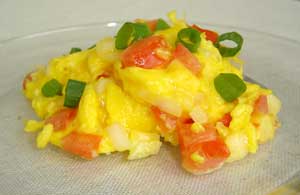Achee
 |
|
Achee is a tropical fruit that is edible only when perfectly ripe – and even then, only a portion of it is nontoxic. It is best known as part of Jamaica’s national dish – achee and saltfish. |
The achee (ackee/akee) tree is found on most islands in the Caribbean. As Jamaica’s national fruit, it is typically served with saltfish for breakfast and as a side with callaloo or Johnnycake. The fried flesh is similar to scrambled eggs in appearance only.
There is a cautionary note for consuming achee. It must be perfectly ripe to be edible; unripened and overripe fruits are toxic enough to cause death. Additionally, once ripe, only the fleshy yellow or whitish portion around the seeds is safe to consume. At the very least, eating this fruit at the wrong stage will cause JVS (Jamaican Vomiting Sickness Syndrome). When the fruit is ready to eat, the bright red pod will open on its own. An unopened pod should never be forced.
Varieties
Achee is also called vegetable brains due to its texture. Fruits are harvested only in Jamaica, but the tree is grown as an ornamental on other islands.
Buying Tips
Purchase canned ackee (the safest way to consume this fruit) from online retailers or at ethnic markets. Many countries do not regulate its import. The U.S. now approves a handful of Jamaican companies for imported product. Always check for the latest brand updates; recalls have occurred.
Usage Tips
Achee must be boiled and the water discarded. Then it can be fried and served with salted cod, onions, bacon, and tomatoes.
Try one of our favorite ackee recipes:
Ackee And Saltfish
Ackee Soup
Tiger Prawns with Ackee Stew And Yam Crush





